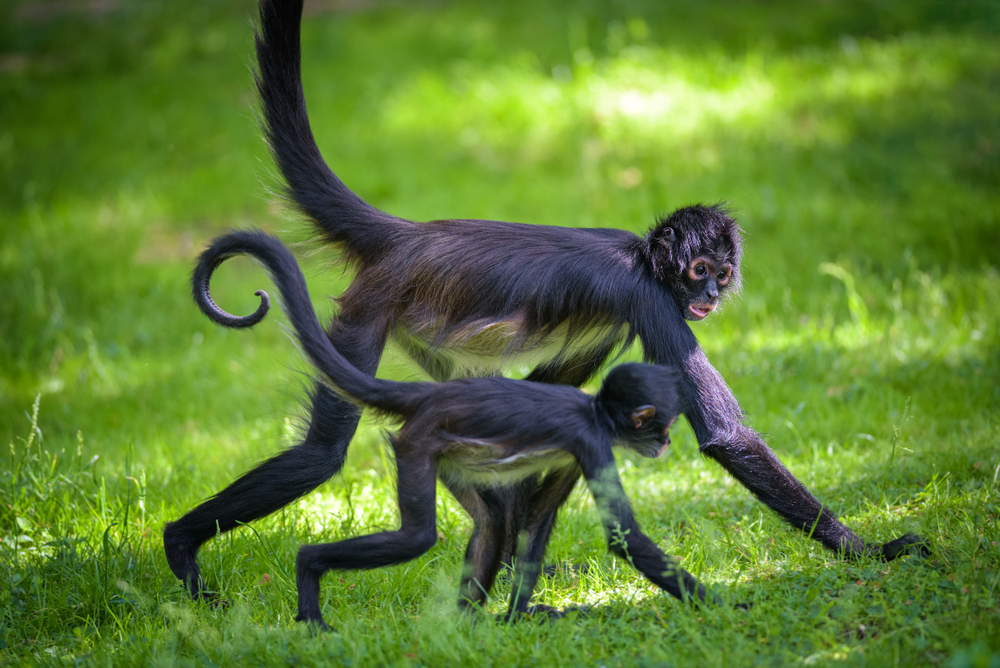10 Fun and Fascinating Facts About Spider Monkeys

Spider monkeys are one of the most intriguing primates inhabiting the tropical rainforests of Central and South America. Known for their acrobatic prowess and highly social nature, these fascinating creatures captivate researchers and animal enthusiasts alike. Understanding spider monkeys not only broadens our knowledge of primate behavior but also highlights the intricate balance of ecosystems where they play a crucial role.
In this blog post, we’ll explore ten fun and fascinating facts about spider monkeys. We’ll delve into their remarkable physical traits, their complex social structures, and their unique communication methods.
You’ll learn about their diet and foraging habits, their geographic distribution, and the various threats they face in the wild.
Additionally, we’ll touch upon their cultural significance and some interesting behavioral traits that set them apart from other primates. By the end of this blog, we hope to inspire a deeper appreciation for these incredible animals and underscore the importance of their conservation.
Fact 1: Spider Monkeys’ Long Limbs and Prehensile Tails
Spider monkeys are easily recognizable by their elongated limbs and highly flexible, prehensile tails. These unique physical traits make them exceptionally adapted to an arboreal lifestyle.
Their long limbs allow them to swing effortlessly from branch to branch, a mode of locomotion known as brachiation, which enables quick and agile movement through the dense forest canopy.
The prehensile tail acts as a “fifth limb,” providing additional support and balance; it is strong enough to grasp branches and even support the monkey’s full body weight.
This combination of long limbs and a versatile tail not only aids in efficient travel and foraging but also helps spider monkeys evade predators by allowing them to navigate through the treetops with ease.
Fact 2: Social Structure and Group Dynamics
Spider monkeys exhibit a complex social structure that is highly organized and geared towards mutual cooperation and survival. Typically forming groups called “troops,” these social assemblies can range from a few individuals to as many as 30 members.
Within these groups, spider monkeys demonstrate intricate social behaviors such as grooming, playing, and vocalizing to maintain strong social bonds and cohesion.
A key aspect of their social interactions involves a fluid fission-fusion dynamic, where the troop may split into smaller subgroups when foraging or resting and later reconvene.
This adaptable social system allows spider monkeys to efficiently manage resources and reduce intra-group competition while ensuring group integrity and cooperation.
Their social intelligence and ability to navigate complex social networks highlight the sophisticated nature of their interactions within the group.
Fact 3: Diet and Foraging Habits
Spider monkeys primarily thrive on a diet rich in fruits, which comprise the bulk of their nutritional intake. They exhibit a keen preference for ripe, fleshy fruits, making them essential frugivores in their ecosystems.
Apart from fruits, their diet occasionally extends to leaves, flowers, and sometimes insects, providing them with the necessary proteins and nutrients.
The role of spider monkeys as seed dispersers is of paramount importance; by consuming a variety of fruits and later excreting the seeds across different parts of the forest, they contribute significantly to the growth and regeneration of plant species.
This seed dispersal mechanism supports the maintenance of biodiversity and aids in forest sustainability, underscoring the ecological impact of spider monkeys in their habitats. Their foraging habits not only sustain their own populations but also foster the ecological health of the tropical rainforests they inhabit.
Fact 4: Geographic Distribution and Habitat
Spider monkeys are predominantly found in the tropical rainforests of Central and South America, with their range extending from southern Mexico through much of Central America, and down into Brazil in South America.
These primates thrive in diverse forest habitats, including lowland rainforests, mangrove forests, and montane forests, preferring dense, undisturbed canopy cover that supports their arboreal lifestyle.
They are particularly abundant in regions with lush vegetation and a high diversity of fruiting trees, which cater to their frugivorous diet.
The dense canopy not only provides ample food resources but also offers protection from predators and human encroachment. Unfortunately, due to deforestation and habitat fragmentation, the geographic distribution of spider monkeys is shrinking, making their conservation all the more critical.
By preserving their natural habitats, we can help ensure the survival of these fascinating creatures and maintain the ecological balance of the forests they inhabit.
Fact 5: Communication Methods
Spider monkeys employ a sophisticated array of communication methods that encompass vocalizations, body language, and even facial expressions to convey information and maintain social bonds. Their vocal repertoire includes a variety of calls such as barks, whinnies, and screeches, each serving a distinct purpose.
For instance, loud calls often function as long-distance communication to locate troop members or alert others to potential dangers. In addition to vocal sounds, spider monkeys use body language extensively; gestures like swinging limbs, tail movements, and playful antics help convey emotions and intentions.
Facial expressions also play a crucial role in non-verbal communication, offering cues about the individual’s mood or social status.
The importance of these communication methods cannot be overstated, as they are vital for coordinating group activities, establishing social hierarchies, and facilitating bonding among group members.
Effective communication helps ensure the troop remains cohesive, making it easier to manage resources, avoid conflicts, and respond to threats, thereby significantly enhancing their chances of survival in the wild.
Fact 6: Reproduction and Lifecycle
Spider monkeys exhibit intriguing reproductive behaviors and lifecycle stages that highlight their adaptation to arboreal life. Mating behaviors in spider monkeys are often initiated by females, who may signal their readiness to mate through specific postures and vocalizations.
The reproductive cycle of spider monkeys is relatively prolonged with a gestation period lasting about 7.5 months. Upon giving birth, typically to a single offspring, mothers exhibit devoted maternal care.
The newborns are initially highly dependent; they cling to their mother’s belly for the first few months before gradually climbing onto her back.
As they grow, juveniles undergo various development stages, starting with intensive nursing followed by learning crucial survival skills such as foraging, climbing, and social interactions, predominantly taught by the mother and other troop members.
The period of juvenile development can last several years, during which the young spider monkeys gain independence and gradually integrate into the larger social dynamics of the troop.
This extended care ensures that the offspring are well-equipped to navigate the complexities of their environment, contributing to the overall stability and cohesion of the group.
Fact 7: Intelligence and Problem-Solving Skills
Spider monkeys exhibit remarkable intelligence and problem-solving abilities that underscore their adaptability and cognitive complexity. Studies and research have highlighted their proficiency in using tools, understanding cause and effect, and demonstrating foresight.
For instance, in controlled experiments, spider monkeys have been observed using sticks to retrieve food from hard-to-reach places, showcasing their ability to manipulate objects and employ strategies to achieve goals.
Additionally, their social intelligence is evident in their interactions; they can navigate complex social structures, recognize individuals, and remember past interactions, which aids in maintaining harmony within the troop.
Observations from the wild also reveal their adeptness at solving ecological challenges, such as selecting the optimal routes through the forest canopy to maximize foraging efficiency while avoiding predators. These cognitive abilities are not only fascinating but are also indicative of their evolutionary success in thriving in diverse and often challenging environments.
Fact 8: Threats and Conservation Status
Spider monkeys are facing multiple threats that jeopardize their populations across Central and South America. Key threats include habitat loss due to rampant deforestation, hunting, and the illegal pet trade.
As tropical rainforests are increasingly cleared for agriculture, logging, and urbanization, spider monkeys lose their primary habitat, leading to fragmented populations and increased vulnerability.
Hunting further exacerbates the decline, with spider monkeys often targeted for bushmeat or captured for the exotic pet market. In response to these challenges, various conservation efforts have been implemented, including habitat protection, reforestation projects, and anti-poaching initiatives.
International and local organizations are working tirelessly to establish protected areas and wildlife corridors to ensure the continuity of spider monkey habitats.
While these efforts have yielded some positive outcomes, such as increased awareness and partial population recoveries in certain areas, the overall effectiveness remains hindered by socio-economic pressures and insufficient enforcement of conservation laws.
Sustainable success will depend on continued collaboration between governments, conservationists, and local communities to address the root causes of habitat destruction and promote long-term ecological balance.
Fact 9: Cultural Significance
Spider monkeys have played a significant role in indigenous cultures and folklore across Central and South America. Revered for their agility and intelligence, they often feature in myths and stories as symbols of cleverness and dexterity.
Certain indigenous tribes view spider monkeys as sacred beings, embodying the spirit of the forest and serving as spiritual messengers.
In various traditional ceremonies, the presence of spider monkeys is believed to bring good fortune and protection from harm. Their impact extends beyond local traditions into broader popular culture, where they frequently appear in media, including animated films, documentaries, and literature.
These depictions often highlight their playful nature and close social bonds, resonating with audiences and fostering a greater appreciation for their conservation.
Whether as subjects of folklore or characters in modern narratives, spider monkeys continue to captivate the human imagination and underscore the need to preserve their natural habitats.
Fact 10: Interesting Behavioral Traits
Spider monkeys exhibit a variety of unique behaviors that continuously intrigue researchers and animal enthusiasts alike. One such behavior is their prehensile tail usage, functioning almost like a fifth limb, allowing them to deftly navigate the forest canopy.
Anecdotes from the wild vividly capture spider monkeys forming complex grooming chains, where multiple individuals groom each other simultaneously, strengthening their social bonds. Notable studies have also documented their remarkable memory and problem-solving skills.
For instance, research conducted by the Max Planck Institute observed spider monkeys’ ability to remember the timing and location of ripe fruit, enabling them to optimize foraging routes effectively.
Another intriguing study revealed that spider monkeys could communicate using a variety of vocalizations and body language, tailoring their interactions to the context, such as warning calls specific to different predators.
These behaviors not only highlight their sophisticated cognitive abilities but also underscore the intricate social structures that support their survival in the wild.
Conclusion
By exploring these 10 fun and fascinating facts about spider monkeys, we’ve gained a deeper appreciation for their incredible abilities and the vital role they play in their ecosystems.
From their sophisticated tool use and remarkable problem-solving skills to their complex social behaviors and cultural significance, spider monkeys demonstrate a level of intelligence and adaptability that is truly awe-inspiring. These traits not only underline their evolutionary success but also highlight their importance in maintaining the ecological balance of their habitats.
However, the survival of spider monkeys is under significant threat due to habitat destruction, hunting, and the illegal pet trade. Preserving these amazing creatures is crucial, not only for their sake but for the health and diversity of tropical rainforests where they reside.
Conserving spider monkeys requires comprehensive efforts involving habitat protection, stringent law enforcement, and fostering awareness and support at local and international levels.
We encourage you, our readers, to become advocates for spider monkey conservation. Whether through donations to reputable wildlife organizations, spreading awareness on social media, or supporting sustainable environmental practices, every action counts.
Together, we can help safeguard the future of spider monkeys and ensure that they continue to thrive for generations to come.




